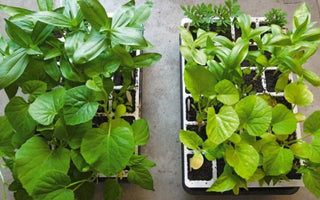A poll by the National Gardening Association revealed that most gardeners do not fertilize their plants. Yet there's no easier way to improve plant health, pest and disease-resistance, flower and fruit production and overall beauty.
I love plants and hate to see them go hungry. I'd also like to see every gardener be as successful as possible. So, if you're one of the millions of gardeners who is not fertilizing your plants, listen up.
 With regular feeding, pots and planters, such as this Viva Self-Watering Hanging Basket, will thrive.
With regular feeding, pots and planters, such as this Viva Self-Watering Hanging Basket, will thrive.Start by purchasing an organic, water-soluble plant food. I say organic, because I'm going to recommend that you fertilize frequently. If you use a synthetic fertilizer, such as "the blue stuff", you'll need to follow the instructions on the package because it's relatively easy to "burn" your plants by applying too much chemical fertilizer. PHC All-Purpose Fertilizer is organically-based, easy to use and very effective.
Start fertilizing your container plants twice a week. Fertilize your houseplants once a week. Feed the plants in your garden every two to three weeks. Fertilize your landscape plants once a month.
Notice what happens. I am confident that you will see a big difference. Your plants will be larger and will produce more flowers and fruit. They'll also be better able to fend off pests and disease, and will have better resistance to drought and other weather stress.
Applying a liquid fertilizer is not a substitute for adding compost and granular organic nutrients to your soil. During the growing season, your plants are like teenagers — they need food and they need it now! Liquid fertilizers are immediately available and provide that quick fix.
Compost and granular organic fertilizers feed your soil as well as your plants. They should be added at the beginning of the growing season as you're preparing your garden or your containers. For best results, apply them again at the end of the season to replace lost nutrients and organic matter. This way, when spring comes, your soil will have plenty of reserves to feed your best garden ever.
For more information about fertilizer—how it works, the importance of pH, organic vs synthetic—please read Fertilizer Basics.
Three Reasons Container Plants Need Extra Help
What's unique about plants growing in pots and planters, that they need their own special fertilizer? Here are a few ways container-grown plants are different from plants growing in the garden.
- Confined roots. In the garden, plant roots venture out several feet or even yards in search of water and nutrients. When grown in pots, on the other hand, plant roots are confined; they can't reach out into the surrounding soil search of nutrients. Container plants depend on you to supply the water and nutrients they need to thrive.
- Soilless planting mixes. Many so-called soil mixes actually contain no soil; they're usually made with peat, coir and/or perlite. The benefits are that they weigh less and offer better drainage than garden soil. However, soilless mixes contain few, if any, nutrients on their own. That means that you must supply all the nutrients the plants need in the form of fertilizer.
- No beneficial microbes. Soilless planting mixes have been sterilized to ensure there are no plant disease organisms. However, that means that there are no beneficial microbes, either. Some types of fertilizers rely on soil microbes to break them down into forms plants can use. That's fine in garden soil, but in containers without any soil microbes, the nutrients must be in a form that's readily available to plants.





